Spatio-Temporal Modeling of Small-Scale Ultrafine Particle Variability Using Generalized Additive Models
Abstract
:1. Introduction
2. Materials and Methods
2.1. Study Domain and Monitoring Campaigns
2.2. Potential Spatial Explanatory Variables
- Urban morphology: the volumes and heights of the buildings were obtained from the Urban Atlas 2012 section of the Copernicus Land Monitoring Service (https://land.copernicus.eu/local/urban-atlas/urban-atlas-2012; accessed on 16 November 2021), while the width and the length of the roads and the distance to them distinguishing among main, secondary and local ones, were evaluated starting from the Open Street Map layers (https://www.openstreetmap.org; accessed on 16 November 2021). Moreover, the urban morphology variables were used to calculate some parameters characterizing the urban canyon (see Supplementary Materials Figure S3).
- Land use: Urban green area, Continuous Urban Fabric representative of continuous areas with high population density, Discontinuity Density representative of discontinuous areas with medium-low population density and Industrial Commercial Public representative of public areas, were calculated in the domain of interest, starting from the data available in the Urban Atlas 2012 section of the Copernicus Monitoring Land Service, at spatial resolution of 10 m. Imperviousness, which was representative of impermeable surfaces, was calculated at a spatial resolution of 100 m.
- Population: the number of inhabitants was considered in the corresponding census sections, with reference to the last ISTAT census of 2011 (https://www.istat.it/it/archivio/104317; accessed on 16 November 2021).
2.3. Potential Temporal Explanatory Variables—Meteorological Parameters
2.4. Potential Spatial and Temporal Explanatory Variables—Traffic Flows
2.5. Models Development
3. Results and Discussion
3.1. Particle Number Concentration Measurements
3.2. Model Evaluation
3.3. Models Performance
3.4. Influence of Explanatory Variables
- -
- Nneg = n. of occurrences with negative p value
- -
- Npos = n. of occurrences with positive p value
Discussion on Influence of Meteorological Parameters
3.5. Spatio-Temporal Predictions of PNC
4. Conclusions
Supplementary Materials
Author Contributions
Funding
Institutional Review Board Statement
Informed Consent Statement
Data Availability Statement
Acknowledgments
Conflicts of Interest
References
- Schraufnagel, D.E. The health effects of ultrafine particles. Exp. Mol. Med. 2020, 52, 311–317. [Google Scholar] [CrossRef] [PubMed]
- Hong, G.; Jee, Y.-K. Special issue on ultrafine particles: Where are they from and how do they affect us? Exp. Mol. Med. 2020, 52, 309–310. [Google Scholar] [CrossRef]
- Stafoggia, M.; Schneider, A.; Cyrys, J.; Samoli, E.; Andersen, Z.J.; Bedada, G.B.; Bellander, T.; Cattani, G.; Eleftheriadis, K.; Faustini, A.; et al. Association between Short-Term Exposure to Ultrafine Particles and Mortality in Eight European Urban Areas. Epidemiology 2017, 28, 172–180. [Google Scholar] [CrossRef] [PubMed]
- Samoli, E.; Andersen, Z.J.; Katsouyanni, K.; Hennig, F.; Kuhlbusch, T.A.J.; Bellander, T.; Cattani, G.; Cyrys, J.; Forastiere, F.; Jacquemin, B.; et al. Exposure to ultrafine particles and respiratory hospitalisations in five European cities. Eur. Respir. J. 2016, 48, 674–682. [Google Scholar] [CrossRef] [PubMed]
- Belleudi, V.; Faustini, A.; Stafoggia, M.; Cattani, G.; Marconi, A.; Perucci, C.A.; Forastiere, F. Impact of fine and ultrafine particles on emergency hospital admissions for cardiac and respiratory diseases. Epidemiology 2010, 21, 414–423. [Google Scholar] [CrossRef] [PubMed]
- Hoek, G.; Beelen, R.; Kos, G.; Dijkema, M.; van der Zee, S.C.; Fischer, P.H.; Brunekreef, B. Land use regression model for ultrafine particles in Amsterdam. Environ. Sci. Technol. 2011, 45, 622–628. [Google Scholar] [CrossRef] [PubMed]
- Abernethy, R.C.; Allen, R.W.; McKendry, I.G.; Brauer, M. A land use regression model for ultrafine particles in Vancouver, Canada. Environ. Sci. Technol. 2013, 47, 5217–5225. [Google Scholar] [CrossRef] [PubMed] [Green Version]
- Saraswat, A.; Apte, J.S.; Kandlikar, M.; Brauer, M.; Henderson, S.B.; Marshall, J.D. Spatiotemporal land use regression models of fine, ultrafine, and black carbon particulate matter in New Delhi, India. Environ. Sci. Technol. 2013, 47, 12903–12911. [Google Scholar] [CrossRef]
- Patton, A.P.; Zamore, W.; Naumova, E.N.; Levy, J.I.; Brugge, D.; Durant, J.L. Transferability and Generalizability of Regression Models of Ultrafine Particles in Urban Neighborhoods in the Boston Area. Environ. Sci. Technol. 2015, 49, 6051–6060. [Google Scholar] [CrossRef] [PubMed] [Green Version]
- Sabaliauskas, K.; Jeong, C.; Yao, X.; Reali, C.; Sun, T.; Evans, G.J. Development of a land-use regression model for ultrafine particles in Toronto, Canada. Atmos. Environ. 2015, 110, 84–92. [Google Scholar] [CrossRef]
- Cattani, G.; Gaeta, A.; Di Menno di Bucchianico, A.; De Santis, A.; Gaddi, R.; Cusano, M.; Ancona, C.; Badaloni, C.; Forastiere, F.; Gariazzo, C.; et al. Development of land-use regression models for exposure assessment to ultrafine particles in Rome, Italy. Atmos. Environ. 2017, 156, 52–60. [Google Scholar] [CrossRef]
- Ghassoun, Y.; Löwner, M.-O. Land use regression models for total particle number concentrations using 2D, 3D and semantic parameters. Atmos. Environ. 2017, 166, 362–373. [Google Scholar] [CrossRef]
- Yang, Z.; Freni-Sterrantino, A.; Fuller, G.W.; Gulliver, J. Development and transferability of ultrafine particle land use regression models in London. Sci. Total Environ. 2020, 740, 140059. [Google Scholar] [CrossRef]
- Olvera, H.A.; Jimenez, O.; Provencio-Vasquez, E. Modeling particle number concentrations along Interstate 10 in El Paso, Texas. Atmos. Environ. 2014, 98, 581–590. [Google Scholar] [CrossRef] [Green Version]
- Rivera, M.; Basagaña, X.; Aguilera, I.; Agis, D.; Bouso, L.; Foraster, M.; Medina-Ramón, M.; Pey, J.; Künzli, N.; Hoek, G. Spatial distribution of ultrafine particles in urban settings: A land use regression model. Atmos. Environ. 2012, 54, 657–666. [Google Scholar] [CrossRef]
- Eeftens, M.; Meier, R.; Schindler, C.; Aguilera, I.; Phuleria, H.; Ineichen, A.; Davey, M.; Ducret-Stich, R.; Keidel, D.; Probst-Hensch, N.; et al. Development of land use regression models for nitrogen dioxide, ultrafine particles, lung deposited surface area, and four other markers of particulate matter pollution in the Swiss SAPALDIA regions. Environ. Health 2016, 15, 53. [Google Scholar] [CrossRef] [PubMed] [Green Version]
- Kerckhoffs, J.; Hoek, G.; Gehring, U.; Vermeulen, R. Modelling nationwide spatial variation of ultrafine particles based on mobile monitoring. Environ. Int. 2021, 154, 106569. [Google Scholar] [CrossRef] [PubMed]
- Zhang, K.M.; Wexler, A.S.; Zhu, Y.F.; Hinds, W.C.; Sioutas, C. Evolution of particle number distribution near roadways. Part II: The ′Road-to-Ambient′ process. Atmos. Environ. 2004, 38, 6655–6665. [Google Scholar] [CrossRef]
- Sioutas, C.; Ralph, J.; Delfino, R.J.; Manisha, S. Exposure assessment for atmospheric ultrafine particles (UFPs) and implications in epidemiologic research. Environ. Health Perspect. 2005, 113, 947–955. [Google Scholar] [CrossRef] [PubMed] [Green Version]
- Zhou, Y.; Levy, I.J. Factors influencing the spatial extent of mobile source air pollution impacts: A meta-analysis. BMC Public Health 2007, 7, 89. [Google Scholar] [CrossRef] [PubMed] [Green Version]
- Ketzel, M.; Berkowicz, R. Modelling the fate of ultrafine particles from exhaust pipe to rural background: An analysis of time scales for dilution, coagulation and deposition. Atmos. Environ. 2004, 38, 2639–2652. [Google Scholar] [CrossRef]
- Kittelson, D.B.; Watts, W.F.; Johnson, J.P. Nanoparticle emissions on Minnesota highways. Atmos. Environ. 2004, 38, 9–19. [Google Scholar] [CrossRef]
- Zhu, Y.; Hindsa, W.C.; Kim, S.; Shen, S.; Sioutas, C. Study of ultrafine particles near a major highway with heavy-duty diesel traffic. Atmos. Environ. 2002, 36, 4323–4335. [Google Scholar] [CrossRef]
- Fujitani, Y.; Kumar, P.; Tamura, K.; Fushimi, A.; Hasegawa, S.; Takahashi, K. Seasonal differences of the atmospheric particle size distribution in a metropolitan area in Japan. Sci. Total Environ. 2012, 437, 339–347. [Google Scholar] [CrossRef] [Green Version]
- Morawska, L.; Ristovski, Z.; Jayaratne, E.R.; Keogh, D.U.; Ling, X. Ambient nano and ultrafine particles from motor vehicle emissions: Characteristics, ambient processing and implications on human exposure. Atmos. Environ. 2008, 42, 8113–8138. [Google Scholar] [CrossRef] [Green Version]
- Kumar, P.; Robins, A.; Vardoulakis, S.; Britter, R. A review of the characteristics of nanoparticles in the urban atmosphere and the prospects for developing regulatory controls. Atmos. Environ. 2010, 44, 5035–5042. [Google Scholar] [CrossRef] [Green Version]
- Kulmala, M.; Vehkamaki, H.; Petaja, T.; Dal Maso, M.; Lauri, A.; Kerminen, V.; Birmilli, W.; McMurry, P. Formation and growth rates of ultrafine atmospheric particles: A review of observations. J. Aerosol Sci. 2004, 35, 143–176. [Google Scholar] [CrossRef]
- Holmes, N. A review of particle formation events and growth in the atmosphere in the various environments and discussion of mechanistic implications. Atmos. Environ. 2007, 41, 2183–2201. [Google Scholar] [CrossRef] [Green Version]
- Raes, F.; Dingenen, R.V.; Vignati, E.; Wilson, J.; Putaud, J.-P.; Seinfeld, J.H.; Adams, P. Formation and cycling of aerosols in the global troposphere. Atmos. Environ. 2000, 34, 4215–4240. [Google Scholar] [CrossRef]
- Birmili, W.; Wiedensohler, A. New particle formation in the continental boundary layer: Meteorological and gas phase parameter influence. Geophys. Res. Lett. 2000, 27, 3325–3328. [Google Scholar] [CrossRef]
- Boy, M.; Kulmala, M. Nucleation events in the continental boundary layer: Influence of physical and meteorological parameters. Atmos. Chem. Phys. 2002, 2, 1–16. [Google Scholar] [CrossRef] [Green Version]
- Ma, N.; Birmili, W. Estimating the contribution of photochemical particle formation to ultrafine particle number averages in an urban atmosphere. Sci. Total Environ. 2015, 512–513, 154–166. [Google Scholar] [CrossRef] [Green Version]
- Salvador, P.; Barreiro, M.; Gómez-Moreno, F.J.; Alonso-Blanco, E.; Artíñano, B. Synoptic classification of meteorological patterns and their impact on air pollution episodes and new particle formation processes in a south European air basin. Atmos. Environ. 2021, 245, 118016. [Google Scholar] [CrossRef]
- Clifford, S.; Choy, S.L.; Hussein, T.; Mengersen, K.; Morawska, L. Using the Generalised Additive Model to model the particle number count of ultrafine particles. Atmos. Environ. 2011, 45, 5934–5945. [Google Scholar] [CrossRef]
- Sartini, C.; Sajani, S.Z.; Ricciardelli, I.; Delgado-Saborit, J.M.; Scotto, F.; Trentini, A.; Ferrari, S.; Poluzzi, V. Ultrafine particle concentrations in the surroundings of an urban area: Comparing downwind to upwind conditions using Generalized Additive Models (GAMs). Environ. Sci. Processes Impacts 2013, 15, 2087–2095. [Google Scholar] [CrossRef] [PubMed]
- Hastie, T.; Tibshirani, R. Generalized Additive Models; Chapman and Hall: New York, NY, USA, 1990. [Google Scholar]
- Hussein, T.; Karppinen, A.; Kukkonen, J.; Härkönen, J.; Aalto, P.P.; Hämeri, K.; Kerminen, V.-M.; Kulmala, M. Meteorological dependence of sizefractionated number concentrations of urban aerosol particles. Atmos. Environ. 2006, 40, 1427–1440. [Google Scholar] [CrossRef]
- Zuur, A.F.; Ieno, E.N.; Walker, N.; Saveliev, A.A.; Smith, G.M. Mixed Effects Models and Extensions in Ecology with R; Springer: Berlin, Germany, 2009; ISBN 978-0-387-87457-9. [Google Scholar]
- Zuur, A.F. Beginner′s Guide to Generalized Additive Models with R; Highland Statistics Ltd.: Newburgh, UK, 2012; ISBN 978-0-957-17412-2. [Google Scholar]
- Wood, S.N. Generalized Additive Models: An Introduction with R, 2nd ed.; Chapman and Hall/CRC: Boca Raton, FL, USA, 2017; ISBN 978-1-4987-2833-1. [Google Scholar]
- Gerling, L.; Löschau, G.; Wiedensohler, A.; Weber, S. Statistical modelling of roadside and urban background ultrafine and accumulation mode particle number concentrations using generalized additive models. Sci. Total Environ. 2020, 703, 134570. [Google Scholar] [CrossRef]
- Weissert, L.F.; Salmond, J.A.; Miskell, G.; Alavi-Shoshtari, M.; Wiliams, D.E. Development of a microscale land use regression model for predicting NO2 concentrations at a heavy trafficked suburban area in Auckland, NZ. Sci. Total Environ. 2018, 619–620, 112–119. [Google Scholar] [CrossRef]
- Eeftens, M.; Beekhuizen, J.; Beelen, R.; Wang, M.; Vermeulen, R.; Brunekreef, B.; Huss, A.; Hoek, G. Quantifying urban street configuration for improvements in air pollution models. Atmos. Environ. 2013, 72, 1–9. [Google Scholar] [CrossRef]
- Miskell, G.; Salmond, J.; Longley, I.; Dirks, K.N. A novel approach in quantifying the effect of urban design features on local-scale air pollution in central urban areas. Environ. Sci. Technol. 2015, 49, 9004–9011. [Google Scholar] [CrossRef]
- Vardoulakis, S.; Solazzo, E.; Lumbreras, J. Intra-urban and street scale variability of BTEX, NO2 and O3 in Birmingham, UK: Implications for exposure assessment. Atmos. Environ. 2011, 45, 5069–5078. [Google Scholar] [CrossRef]
- Grange, S.K.; Dirks, K.N.; Costello, S.B.; Salmond, J.A. Cycleways and footpaths: What separation is needed for equivalent air pollution dose between travel modes? Transp. Res. Part D Transp. Environ. 2014, 32, 111–119. [Google Scholar] [CrossRef]
- Salmond, J.A.; McKendry, I.G. Influences of Meteorology on Air Pollution Concentrations and Processes in Urban Areas. In Air Quality in Urban Environment; Royal Society of Chemistry: London, UK, 2009; pp. 23–41. [Google Scholar]
- Salmond, J.A.; Williams, D.E.; Laing, G.; Kingham, S.; Dirks, K.; Longley, I.; Henshaw, G.S. The influence of vegetation on the horizontal and vertical distribution of pollutants in a street canyon. Sci. Total Environ. 2013, 443, 287–298. [Google Scholar] [CrossRef] [PubMed]
- Shi, Y.; Lau, K.K.; Ng, E. Developing street-level PM2.5 and PM10 land use regression models in high-density Hong Kong with urban morphological factors. Environ. Sci. Technol. 2016, 50, 8178–8187. [Google Scholar] [CrossRef] [PubMed]
- Lin, M.Y.; Guo, Y.X.; Chen, Y.C.; Chen, W.T.; Young, L.H.; Lee, K.J.; Wu, Z.Y.; Tsai, P.J. An instantaneous spatiotemporal model for predicting traffic-related ultrafine particle concentration through mobile noise measurements. Sci. Total Environ. 2018, 636, 1139–1148. [Google Scholar] [CrossRef]
- Pelliccioni, A.; Monti, P.; Cattani, G.; Boccuni, F.; Cacciani, M.; Canepari, S.; Capone, P.; Catrambone, M.; Cusano, M.; D′Ovidio, M.C.; et al. Integrated Evaluation of Indoor Particulate Exposure: The VIEPI Project. Sustainability 2020, 12, 9758. [Google Scholar] [CrossRef]
- Bruse, M.; Fleer, H. Simulating surface–plant–air interactions inside urban environments with a three-dimensional numerical model. Environ. Model. Softw. 1998, 13, 373–384. [Google Scholar] [CrossRef]
- Di Bernardino, A.; Iannarelli, A.M.; Casadio, S.; Mevi, G.; Campanelli, M.; Casasanta, G.; Cacciani, M. On the effect of sea breeze regime on aerosols and gases properties in the urban area of Rome, Italy. Urban Clim. 2021, 37, 100842. [Google Scholar] [CrossRef]
- Patton, A.P.; Collins, C.; Naumova, E.N.; Zamore, W.; Brugge, D.; Durant, J.L. An hourly regression model for ultrafine particles in a near-highway urban area. Environ. Sci. Technol. 2014, 48, 3272–3280. [Google Scholar] [CrossRef] [Green Version]
- Wyngard, J.C. Turbulence in the atmosphere. Bound.–Layer Meteorol. 2011, 139, 543–549. [Google Scholar]
- Iannarelli, A.M.; Di Bernardino, A.; Casadio, S.; Bassani, C.; Cacciani, M.; Campanelli, M.; Casasanta, G.; Cadau, E.; Diémoz, H.; Mevi, G.; et al. The Boundary-Layer Air Quality-Analysis Using Network of INstruments (BAQUNIN) Supersite for Atmospheric Research and Satellite Validation over Rome Area. Bull. Am. Meteorol. Soc. 2021, under review.
- Pichelli, E.; Ferretti, R.; Cacciani, M.; Siani, A.M.; Ciardini, V.; Di Iorio, T. The role of urban boundary layer investigated with high-resolution models and ground-based observations in Rome area: A step towards understanding parameterization potentialities. Atmos. Meas. Tech. 2014, 7, 315–332. [Google Scholar] [CrossRef] [Green Version]
- Wood, S. Mixed GAM Computation Vehicle with Automatic Smoothness Estimation. 2019. Available online: https://cran.r-project.org/web/packages/mgcv/mgcv.pdf (accessed on 16 November 2021).
- R Core Team. R: A Language and Environment for Statistical Computing; R Foundation for Statistical Computing: Vienna, Austria, 2020; Available online: https://www.R-project.org/ (accessed on 16 November 2021).
- RStudio Team. RStudio: Integrated Development for R. RStudio; PBC: Boston, MA, USA, 2020; Available online: https://www.rstudio.com/ (accessed on 16 November 2021).
- Marconi, A.; Cattani, G.; Cusano, M.; Ferdinandi, M.; Inglessis, M.; Viviano, G.; Settimo, G.; Forastiere, F. Two-Years of fine and ultrafine particles measurements in Rome, Italy. J. Toxicol. Environ. Health 2007, 70, 213–221. [Google Scholar] [CrossRef] [PubMed]
- Cattani, G.; Di Menno di Bucchianico, A.; Dina, D.; Inglessis, M.; Notaro, C.; Settimo, G.; Viviano, G.; Marconi, A. Evaluation of the temporal variation of air quality in Rome, Italy from 1999 to 2008. Ann. Ist. Super. Sanità 2010, 46, 242–253. [Google Scholar] [PubMed]
- Paatero, P.; Aalto, P.; Picciotto, S.; Bellander, T.; Castano, G.; Cattani, G.; Cyrys, J.; Kulmala, M.; Lanki, T.; Nyberg, F.; et al. Estimating Aerosol Particle number concentrations in the five HEAPPS cities on the basis of measured air pollution and meteorological variables. Atmos. Environ. 2005, 39, 2261–2273. [Google Scholar] [CrossRef]
- Hastie, T.; Tibshirani, R.; Friedman, J. The Elements of Statistical Learning; Springer: New York, NY, USA, 2001. [Google Scholar]
- de Foy, B.; Schauer, J.J. Changes in speciated PM2.5 concentrations in Fresno, California, due to NOx reductions and variations in diurnal emission profiles by day of week. Elem. Sci. Anth. 2019, 7, 45. [Google Scholar] [CrossRef]
- Hua, J.; Zhang, Y.; de Foy, B.; Shang, J.; Schauer, J.J.; Mei, X.; Sulaymon, I.D.; Han, T. Quantitative estimation of meteorological impacts and the COVID-19 lockdown reductions on NO2 and PM2.5 over the Beijing area using Generalized Additive Models (GAM). J. Environ. Manag. 2021, 291, 112676. [Google Scholar] [CrossRef]
- Olivares, G.; Johansson, C.; Strom, J.; Hasson, H.-C. The role of ambient temperature for particle number concentrations in a street canyon. Atmos. Environ. 2007, 41, 2145–2155. [Google Scholar] [CrossRef]
- Giechaskiel, B.; Ntziachristos, L.; Samaras, Z.; Scheer, V.; Casati, R.; Vogt, R. Formation potential of vehicle exhaust nucleation mode particles on-road and in the laboratory. Atmos. Environ. 2005, 39, 3191–3198. [Google Scholar] [CrossRef]
- Ronkko, T.; Virtanen, A.; Vaaraslahti, K.; Koskinen, J.; Pirjola, L.; Lappi, M. Effect of dilution conditions and driving parameters on nucleation mode particles in diesel exhaust: Laboratory and on-road study. Atmos. Environ. 2006, 40, 2893–2901. [Google Scholar] [CrossRef]
- Stull, R.B. An Introduction to Boundary Layer Meteorology; Springer: Berlin, Germany, 1988. [Google Scholar]
- Woo, K.S.; Chen, D.R.; Pui, D.Y.H.; McMurry, P.H. Measurement of Atlanta Aerosol Size Distributions: Observations of Ultrafine particle Events. Aerosol Sci. Tech. 2001, 34, 75–87. [Google Scholar] [CrossRef]
- Hussein, T.; Hameri, K.; Aalto, P.; Paatero, P.; Kulmala, M. Modal structure and spatial-temporal variations of urban and suburban aerosols in Helsinki-Finland. Atmos. Environ. 2005, 39, 1655–1668. [Google Scholar] [CrossRef]
- Pushpawela, B.; Jayaratne, R.; Morawska, L. The influence of wind speed on new particle formation events in an urban environment. Atmos. Res. 2019, 215, 37–41. [Google Scholar] [CrossRef]
- Janhall, S.; Olofson, F.; Andersson, P.; Pettersson, J.; Hallquist, M. Evolution of the urban aerosol during winter temperature inversion episodes. Atmos. Environ. 2006, 40, 5355–5366. [Google Scholar] [CrossRef]
- Vignati, E.; Berkowicz, R.; Palmgren, F.; Lyck, E.; Hummelshoj, P. Transformation of size distributions of emitted particles in streets. Sci. Total Environ. 1999, 235, 37–49. [Google Scholar] [CrossRef]
- Gidhagen, L.; Johansson, C.; Langner, J.; Olivares, G. Simulation of NOx and ultrafine particles in a street canyon in Stockholm, Sweden. Atmos. Environ. 2004, 38, 2029–2044. [Google Scholar] [CrossRef]
- Nikolova, I.; Janssen, S.; Vos, P.; Berghmans, P. Modelling the mixing of size resolved traffic induced and background ultrafine particles from an urban street canyon to adjacent backyards. Aerosol Air Qual. Res. 2014, 14, 145–155. [Google Scholar] [CrossRef]
- Birmili, W.; Weinhold, K.; Rasch, F.; Sonntag, A.; Sun, J.; Merkel, M.; Wiedensohler, A.; Bastian, S.; Schladitz, A.; Loschau, G.; et al. Long-term observations of tropospheric particle number size distributions and equivalent black carbon mass concentrations in the German Ultrafine Aerosol Network (GUAN). Earth Syst. Sci. Data 2016, 8, 355–382. [Google Scholar] [CrossRef] [Green Version]
- Ketzel, M.; Frohn, L.M.; Christensen, J.H.; Brandt, J.; Massling, A.; Andersen, C.; Im, U.; Jensen, S.S.; Khan, J.; Nielsen, O.-K.; et al. Modelling ultrafine particle number concentrations at address resolution in Denmark from 1979 to 2018—Part 2: Local and street scale modelling and evaluation. Atmos. Environ. 2021, 264, 118633. [Google Scholar] [CrossRef]
- Di Menno di Bucchianico, A.; Cusano, M.; Gaddi, R.; Gaeta, A.; Leone, G.; Boccuni, F.; Ferrante, R.; Pelliccioni, A.; Cattani, G. Indoor and Outdoor Particle Number Concentration in the Sapienza University Campus of Rome. Sustainability 2021, 13, 9126. [Google Scholar] [CrossRef]
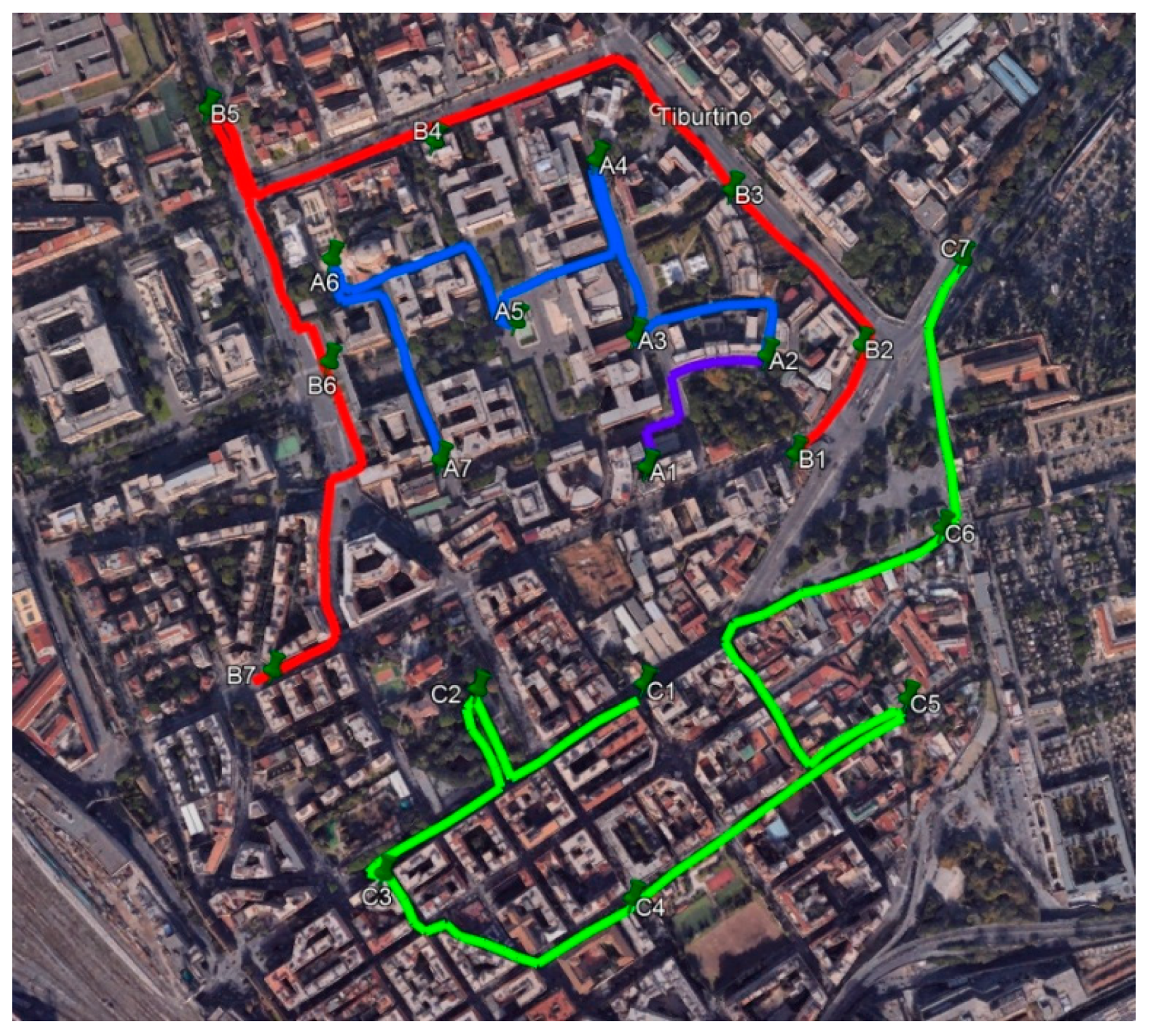

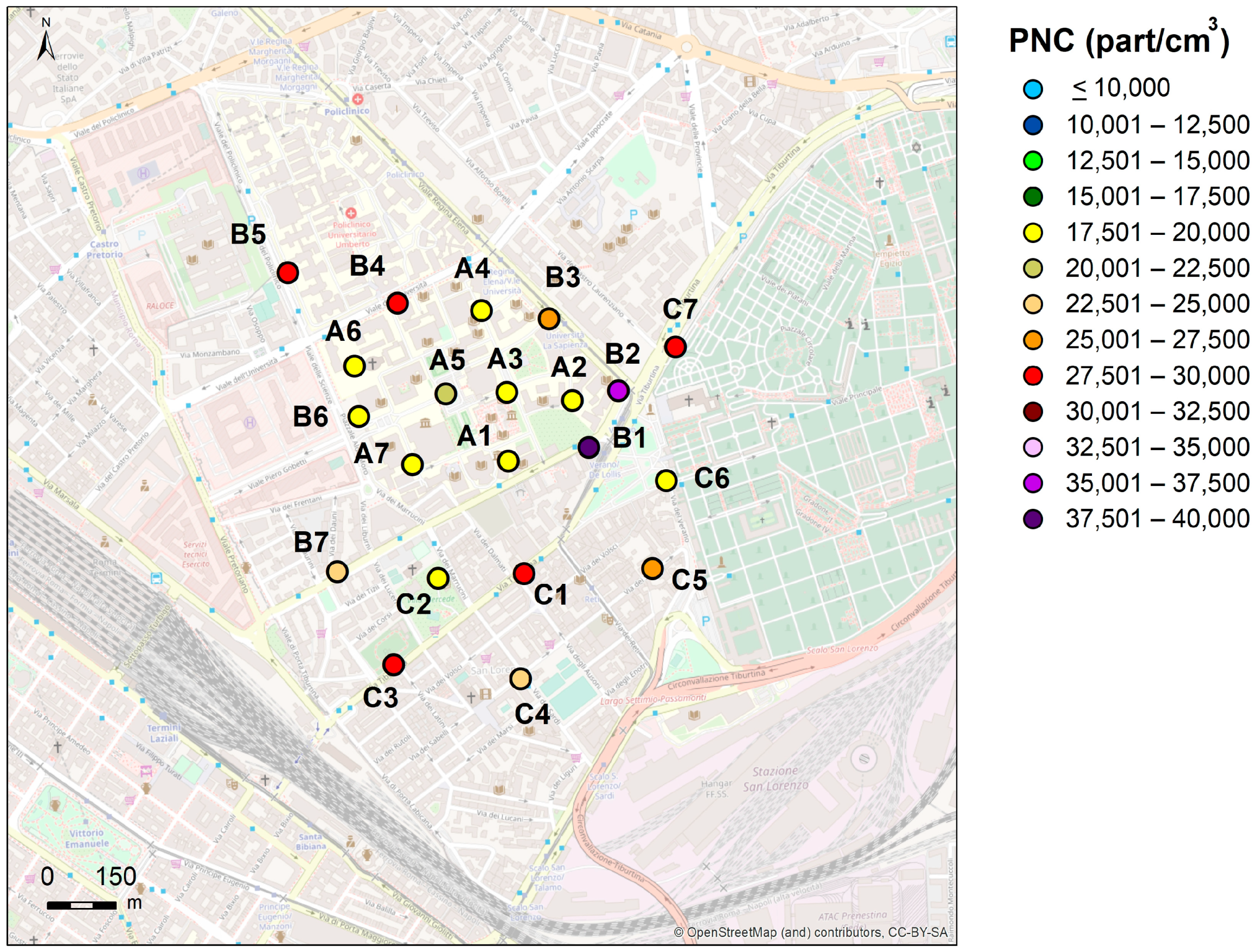
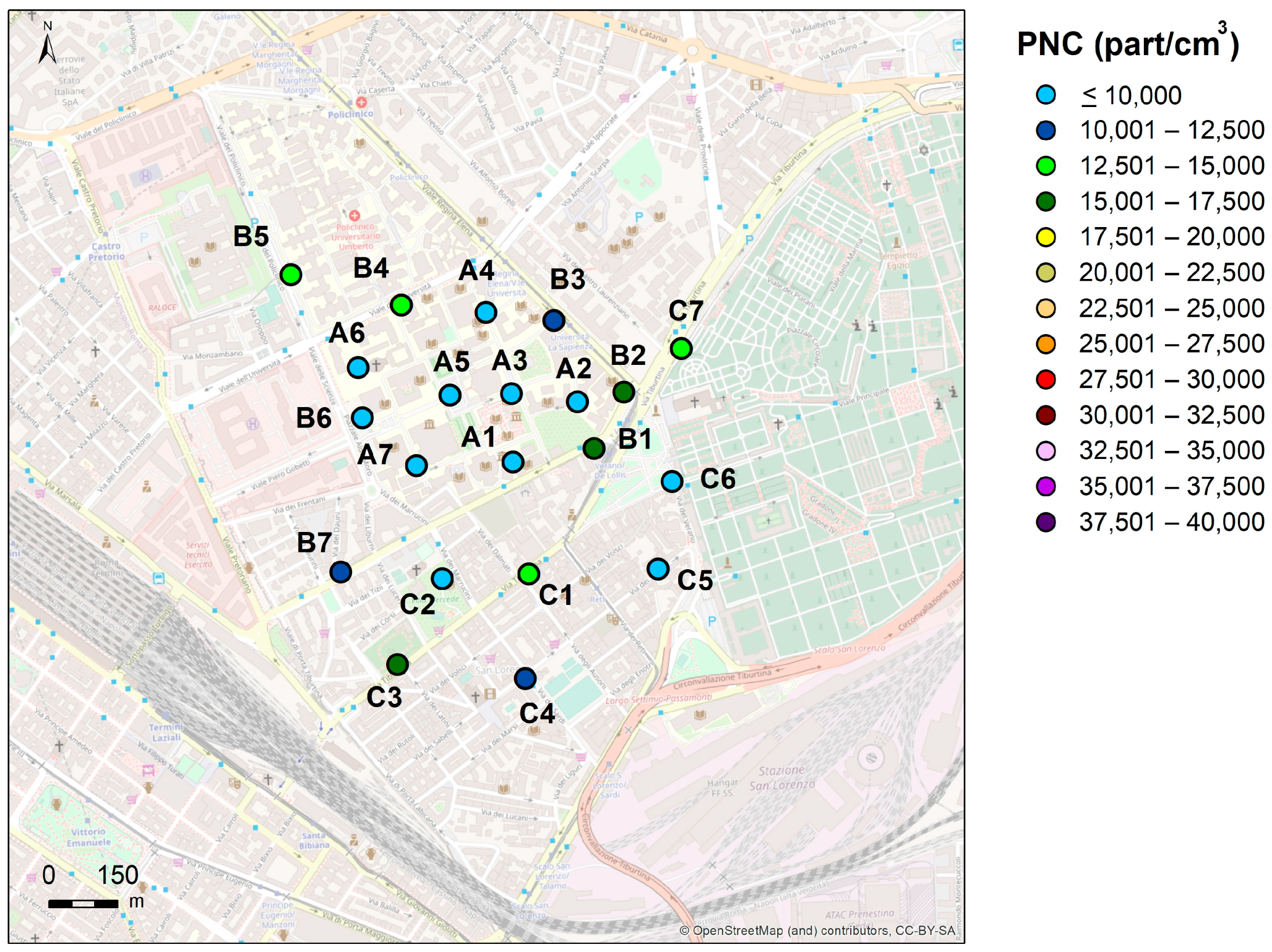

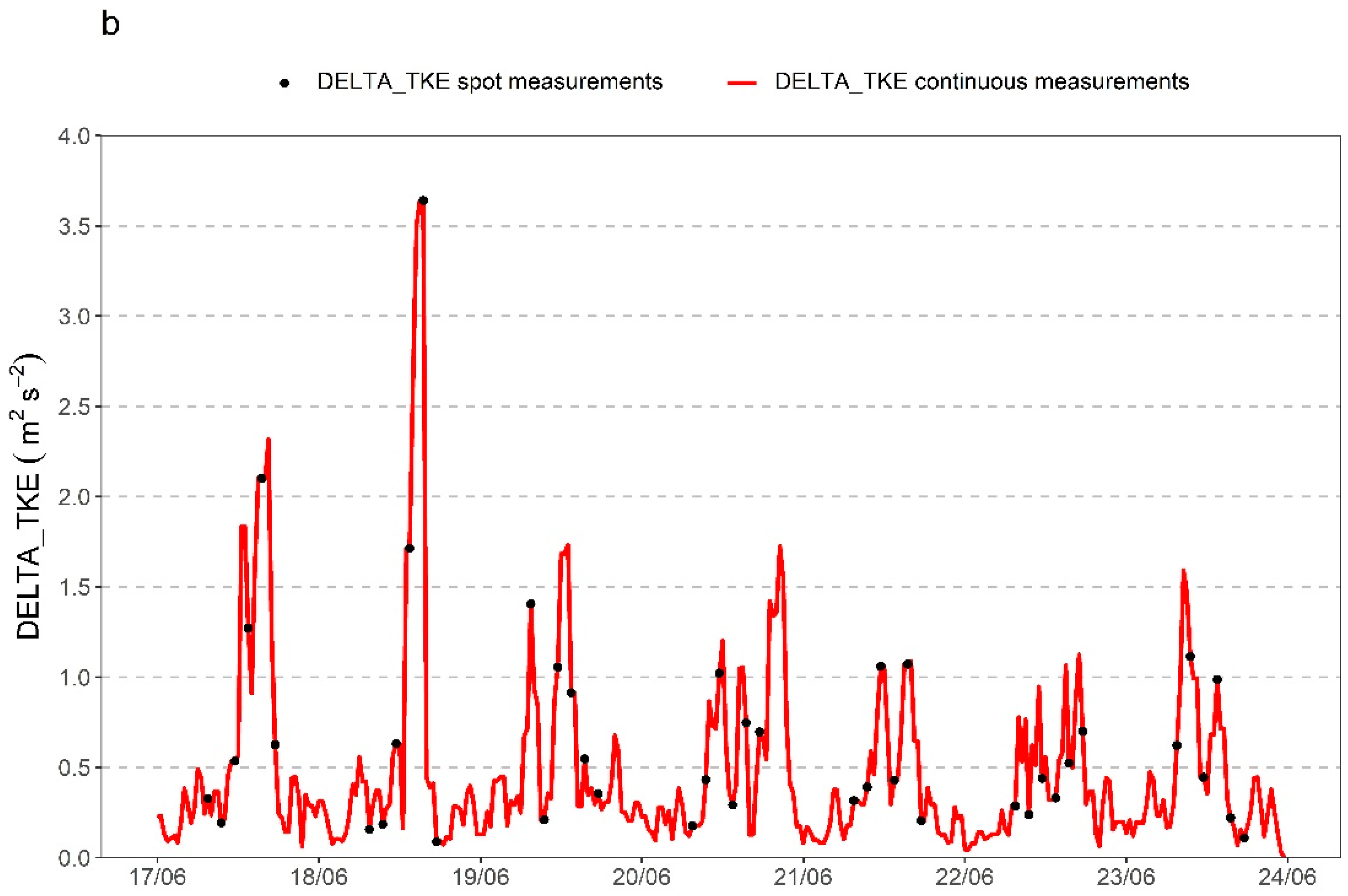
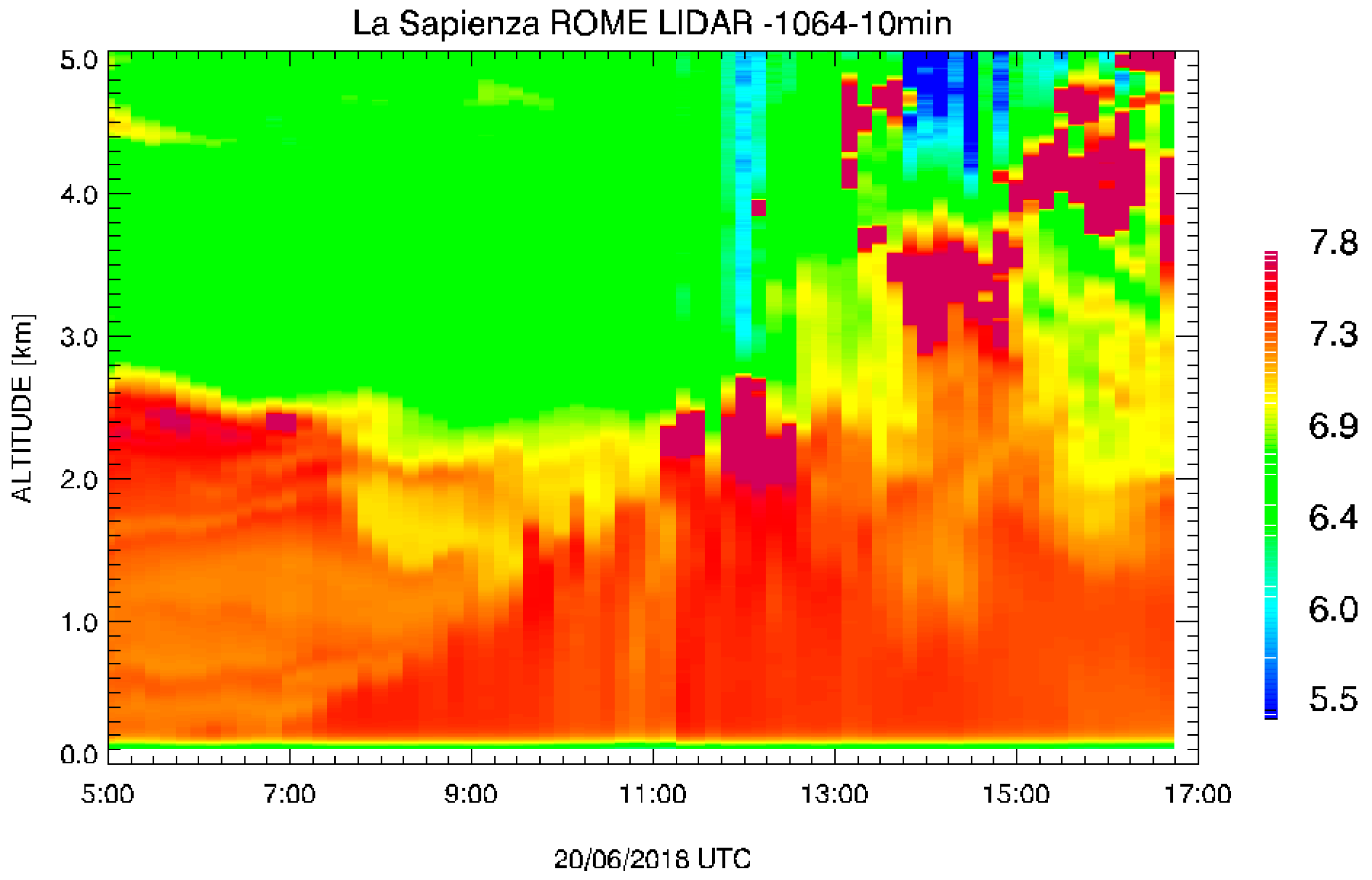


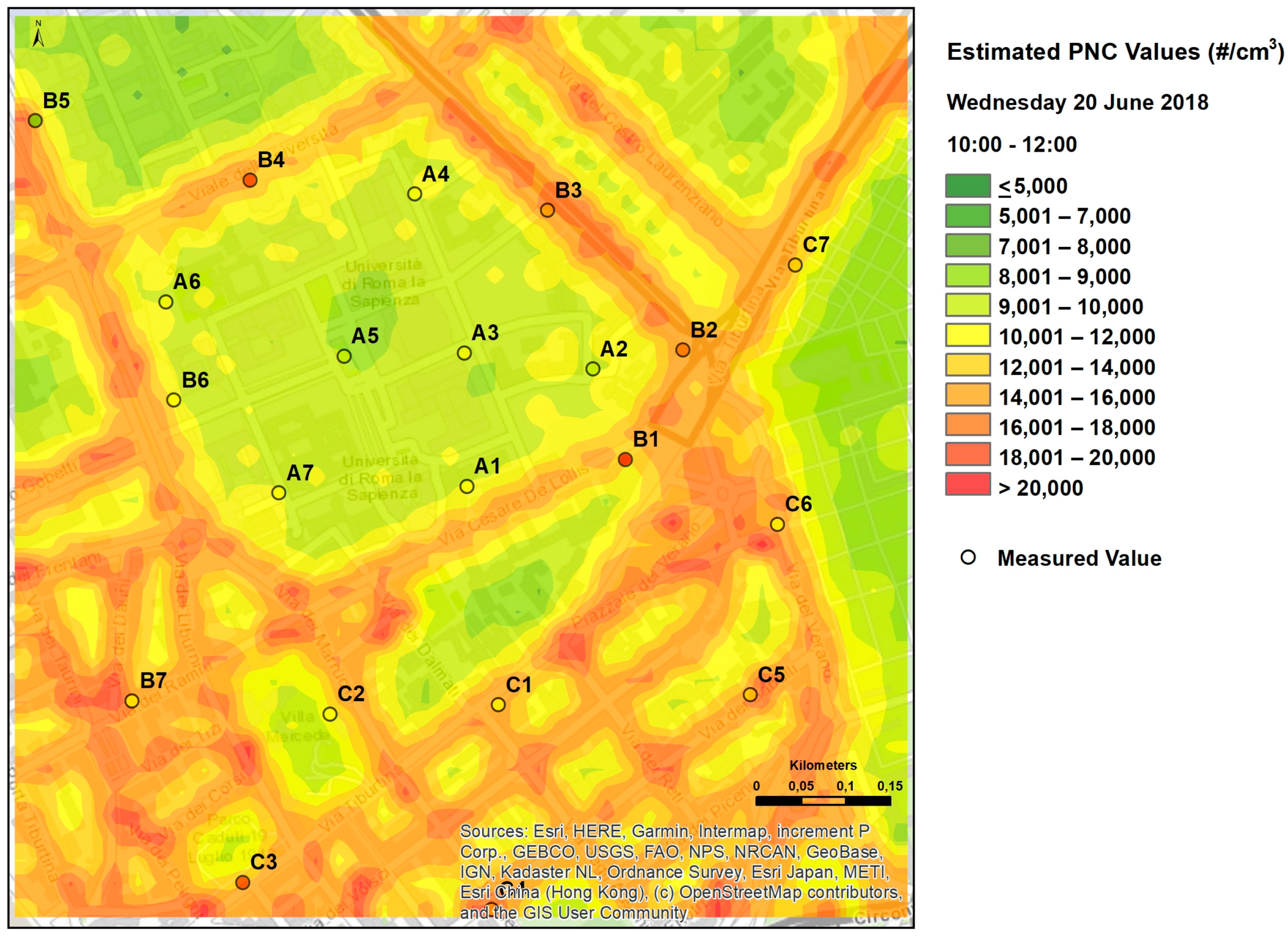

| Variable [UM] | Coefficient (SE) | t Value | Pr (>|t|) |
|---|---|---|---|
| Intercept | 9.90 (0.355) | 278.8 | <0.001 |
| Traff [vehicles/h] | 1.20 × 10−4 (5.22 × 10−5) | 2.3 | 0.022 |
| Smoothing Terms [UM] | EDF | F | p Value | K’ | k Index |
|---|---|---|---|---|---|
| s(Urel) [m−1] | 8.342 | 33.705 | <0.001 | 9.00 | 0.98 |
| s(Distinv2, k = 15) [m−2] | 12.293 | 7.379 | <0.001 | 14.00 | 0.98 |
| s(DELTA_TKE) [m2/s2] | 8.975 | 19.283 | <0.001 | 9.00 | 0.99 |
| Variable [UM] | Coefficients (SE) | t Value | Pr (>|t|) |
|---|---|---|---|
| Intercept | 9.21 (0.011) | 835 | <0.001 |
| Smoothing Terms [UM] | EDF | F | p Value | K’ | k Index |
|---|---|---|---|---|---|
| s(Vscal) [m/s] | 9.000 | 10.087 | <0.001 | 9.00 | 1.00 |
| s(Distinv2, k = 12) [m−2] | 9.728 | 15.370 | <0.001 | 11.00 | 1.08 |
| s(Hmixmin) [m] | 6.504 | 21.105 | <0.001 | 9.00 | 1.00 |
| s(Traff) [vehicles/h] | 3.561 | 2.577 | 0.029 | 9.00 | 1.08 |
| Variable [UM] | Coefficients (SE) | t Value | Pr (>|t|) |
|---|---|---|---|
| Intercept | 9.57 (0.022) | 436 | <0.001 |
| Traff [vehicles/h] | 6.86 × 10−5 (2.45 × 10−5) | 2.80 | 0.005 |
| Smoothing Terms [UM] | EDF | F | p Value | K’ | k Index |
|---|---|---|---|---|---|
| s(Tdry, k = 15) [°C] | 12.29 | 79.04 | <0.001 | 14.0 | 1.04 |
| s(Distinv2, k = 12) [m−2] | 10.74 | 23.24 | <0.001 | 11.0 | 0.98 |
| s(Vscal) [m/s] | 13.89 | 17.81 | <0.001 | 14.0 | 1.04 |
| s(DELTA_TKE) [m2/s2] | 13.45 | 15.00 | <0.001 | 14.0 | 1.04 |
| Model | R2 adj | R2 | GCV | AIC | BIC | RMSE [part/cm3] |
|---|---|---|---|---|---|---|
| Cold season | 0.690 | 71.1% | 0.073 | 93.95 | 227,3 | 7743 |
| Warm season | 0.779 | 79.7% | 0.047 | −76.2 | 43.558 | 2832 |
| Overall | 0.835 | 84.5% | 0.06 | 13.482 | 278.646 | 5562 |
| Cold Season Model | |||||
| s(Urel) | s(DELTA_TKE) | Traff | s(Distnv2) | ||
| Median relative effect | −15.3% | 18.2% | 6.65% | 1.84% | |
| NR | 1.3 | 0.4 | 0.0 | 0.9 | |
| Warm season model | |||||
| s(Vscal) | s(Hmixmin) | s(Traff) | s(Distnv2) | ||
| Median relative effect | −27.6% | 45.8% | 1.46% | −7.69% | |
| NR | 2.4 | 0.4 | 0.8 | 1.1 | |
| Overall model | |||||
| s(Tdry) | s(DELTA_TKE) | s(Vscal) | Traff | s(Distnv2) | |
| Median relative effect | −0.74% | −3.35% | −7.10% | 3.38% | −1.19% |
| NR | 1.0 | 2.0 | 1.1 | 0.0 | 1.1 |
| Cold Season Model | |||||
| Time bands | s(Urel) | s(DELTA_TKE) | Traff | s(Distnv2) | |
| 8 | 12.0% | 22.9% | 4.27% | 1.84% | |
| 12 | −20.5 | 11.5% | 8.67% | 1.84% | |
| 16 | −19.4% | 23.4% | 7.79% | 1.84% | |
| Warm season model | |||||
| Time bands | s(Vscal) | s(Hmixmin) | s(Traff) | s(Distnv2) | |
| 8 | −23.1% | 49.1% | 0.55% | −7.69% | |
| 12 | −21.6% | −2.03% | 1.85% | −7.69% | |
| 16 | −44.8% | 45.8% | 1.84% | −7.69% | |
| Overall model | |||||
| Time bands | s(Vscal) | s(Tdry) | s(DELTA_TKE) | Traff | s(Distnv2) |
| 8 | 43.3% | 19.7% | −18.2% | 2.55% | −1.19% |
| 12 | −16.4% | −28.9% | −1.63% | 4.08% | −1.19% |
| 16 | −11.2% | −15.1% | −2.04% | 3.90% | −1.19% |
Publisher’s Note: MDPI stays neutral with regard to jurisdictional claims in published maps and institutional affiliations. |
© 2021 by the authors. Licensee MDPI, Basel, Switzerland. This article is an open access article distributed under the terms and conditions of the Creative Commons Attribution (CC BY) license (https://creativecommons.org/licenses/by/4.0/).
Share and Cite
Gaeta, A.; Leone, G.; Di Menno di Bucchianico, A.; Cusano, M.; Gaddi, R.; Pelliccioni, A.; Reatini, M.A.; Di Bernardino, A.; Cattani, G. Spatio-Temporal Modeling of Small-Scale Ultrafine Particle Variability Using Generalized Additive Models. Sustainability 2022, 14, 313. https://doi.org/10.3390/su14010313
Gaeta A, Leone G, Di Menno di Bucchianico A, Cusano M, Gaddi R, Pelliccioni A, Reatini MA, Di Bernardino A, Cattani G. Spatio-Temporal Modeling of Small-Scale Ultrafine Particle Variability Using Generalized Additive Models. Sustainability. 2022; 14(1):313. https://doi.org/10.3390/su14010313
Chicago/Turabian StyleGaeta, Alessandra, Gianluca Leone, Alessandro Di Menno di Bucchianico, Mariacarmela Cusano, Raffaela Gaddi, Armando Pelliccioni, Maria Antonietta Reatini, Annalisa Di Bernardino, and Giorgio Cattani. 2022. "Spatio-Temporal Modeling of Small-Scale Ultrafine Particle Variability Using Generalized Additive Models" Sustainability 14, no. 1: 313. https://doi.org/10.3390/su14010313
APA StyleGaeta, A., Leone, G., Di Menno di Bucchianico, A., Cusano, M., Gaddi, R., Pelliccioni, A., Reatini, M. A., Di Bernardino, A., & Cattani, G. (2022). Spatio-Temporal Modeling of Small-Scale Ultrafine Particle Variability Using Generalized Additive Models. Sustainability, 14(1), 313. https://doi.org/10.3390/su14010313







